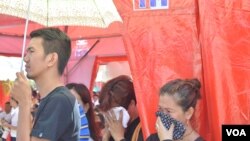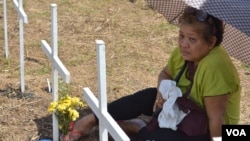One year after a super typhoon shattered millions of people’s lives in the central Philippines, the massive storm is still affecting some of the island nation's poorest residents, particularly their quest for regular employment.
In a small fishing community east of downtown Tacloban, a city of Leyte province where most of the 7,300 dead or missing resided, some tiny fiberglass boats sit unused, collecting rainwater on the shore among overgrown beach plants. Others remain securely fastened to the tiny shacks that dot the beach.
Roderick Lago no longer lives in this neighborhood. But his boat is still docked here and he makes the trip from his temporary shelter home some distance away to try to fish with a rod and hook, which only guarantees a miniscule catch.
He said that if he is not earning, he cannot pay the fare to come. He said it has been almost a month since he has been able to fish. But if they would just give him a net, he said, then he could make a real catch.
Lago said he has been waiting five months for the government to provide fishing nets and other materials.
Like the nearly 50,000 fishermen in Leyte province, Lago lost his boat when 315 kilometer per hour winds and several tsunami-like storm surges swept through. Many received boats – or bancas as they are locally called – that were donated by various international and local groups.
The regional office of the Bureau of Fisheries and Aquatic Resources is distributing the nets. Regional Director Juan Albaladejo said his office is constantly giving away the tools, but says they do not always reach the fishermen in need, partly because of communication breakdowns with the local non-government agencies.
“So what happened is they did not check to our master list, so some of the fishermen - or [sometimes] not even a fisherman - would receive a boat. It’s becoming a problem really,” said Albaladejo.
Lago, who is 26 years old, grew up on these shores and comes from generations of fishermen. He said he will continue the family’s trade, even if it means working as an assistant to other fishermen.
Lago's decision is an exception in Tacloban. Mayor Alfred Romualdez said the population of fisher folk in his city has been steadily declining. And since the bancas were given away by aid agencies there have been “more boats than fishermen.” He foresees a time when people will start aiming for higher skilled work.
Typhoon Haiyan ruined tens of millions of coconut trees, leaving about a million farmers without an income and seeking new livelihoods.
Catholic Relief Services livelihood and agriculture program manager Ana Ferreira said the more than 2,000 survivors the agency has helped have been very pragmatic.
“With coconut farming, it’s going to be six to eight years before they can have a new harvest and people are very aware of this so they’re very eager to find alternative livelihoods,” said Ferreira.
Jeddah Palo decided to enter a government technical skills class for welding with the help of CRS. The 24-year old used to help her father harvest coconuts to be sold for making oil. But she said after the storm their trees were “totally washed out” and there was no regular income.
“I didn’t want to go back after the first day,” she said. “Because they asked me, ‘Can you handle that? You’re a woman.’ I was afraid they would be right and that I wouldn’t be able to handle it because I’m a woman and they’re all men.”
Despite her anxiety as the class's only woman, two weeks ago she passed the certification exam.
Now Palo has her sights set on a job opportunity. A CRS economic development officer is arranging a meeting between Palo and a woman who owns a transportation business and is looking for a welder.















